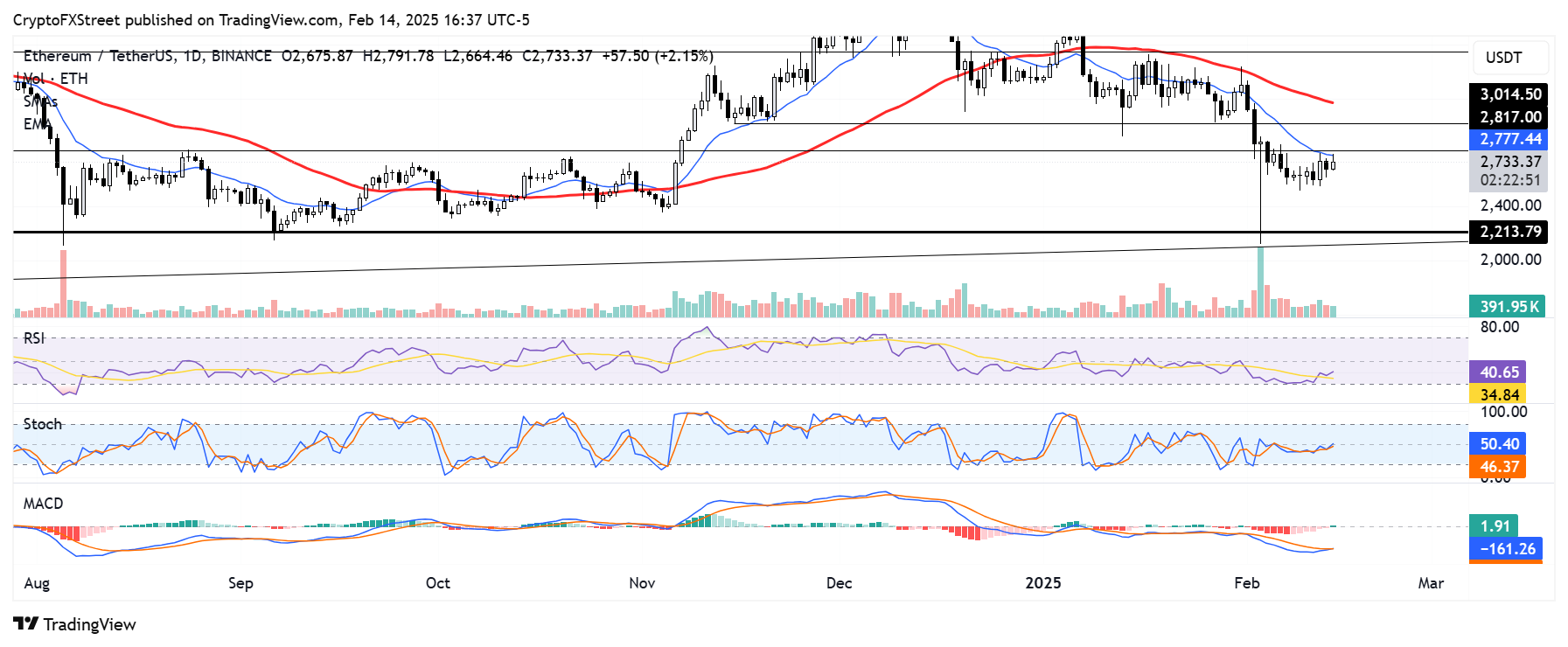Ethereum Price Forecast: Pectra upgrade could alter investor sentiment as ETH retests $2,817
Ethereum price today: $2,740
- Ethereum Foundation announced that the Pectra upgrade will continue as planned with the Holesky and Sepolia testnet upgrades set for February 24 and March 5.
- Ethereum options data shows a slight increase in optimism among traders.
- ETH retested the $2,817 critical resistance as its technical indicators show slight bullish signs.
Ethereum (ETH) is up 3% on Friday following the Ethereum Foundation's official announcement of the dates for the Pectra upgrade to hit the Holesky and Sepolia testnets. The top altcoin tested the $2,817 level upon the announcement, with technical indicators showing mild bullish signs.
Ethereum Pectra upgrade announcement lifts market sentiment
Ethereum developers are on track to ship the Pectra upgrade on testnets Holesky and Sepolia on February 24 and March 5, respectively.
After reaching an agreement in the recent All Core Developers Consensus (ACDC) call on Thursday, the Ethereum Foundation officially announced the dates in a blog post on Friday.
If the testnet upgrades go as planned, developers could decide to ship Pectra on the mainnet sometime around April 8.
The Pectra upgrade features eleven Ethereum Improvement Proposals (EIPs) that center majorly around transforming regular wallets or Externally Owned Accounts (EOAs) to smart accounts, improving validator UX and blob expansion to strengthen Ethereum's data availability (DA) capacity.
In anticipation of the Pectra upgrade, validators have increased Ethereum's gas limit from 30M to 36M, resulting in cheaper and fewer failed transactions for users.
"With periods of sub 1 gwei gas prices, transactions are the cheapest they have been in several years," crypto analytics platform IntoTheBlock highlighted in a note to FXStreet.
However, the gas reduction hasn't translated to increased transaction volume on the L1, contrary to expectations. "Post gas reduction highs for transactions has peaked at 1.34M daily transactions, below monthly highs of 1.39M," noted IntoTheBlock.
This could partly be due to the wider crypto market crash and eventual consolidation since President Donald Trump's decision to tariff US trade partners.
However, the market trend could shift in the coming weeks as options investors have flipped from a bearish to a cautious optimistic sentiment, according to data from crypto derivatives platform Derive.
"Over the past 24 hours, the probability of ETH touching $2K before March 28 has decreased to 16.6% from 25% previously [and] the probability of ETH hitting $4K by June 27 has risen to 34%, up from 28.5% in the last 24 hours," noted Sean Dawson, Derive's Head of Research
"For ETH, 34.2% of premiums were calls bought and 27.4% [were] calls sold, signaling a moderate optimism but also caution in expectations," he added.
Ethereum Price Forecast: ETH technical indicators show mild bullish signs
ETH is attempting to retest a rectangular channel's key resistance at $2,817 near the 14-day Exponential Moving Average (EMA).
Since the market crash on February 3, the top altcoin has consistently seen a rejection near $2,817, making it a critical resistance level. Notably, ETH consolidated for four months — between August and November — the last time its price dipped below $2,817.

ETH/USDT daily chart
A move above this key resistance could switch ETH's short-term trend toward a bullish outlook.
The Relative Strength Index (RSI) and Stochastic Oscillator (Stoch) both bounced off their respective moving average lines.
Meanwhile, the Moving Average Convergence Divergence (MACD) line is testing its red moving average line after its histogram bars crossed above the neutral level.
These indicators signal a mild shift toward a dominant bullish momentum in the underlying market trend.
A daily candlestick close below $2,200 will invalidate the thesis.
Ethereum FAQs
Ethereum is a decentralized open-source blockchain with smart contracts functionality. Its native currency Ether (ETH), is the second-largest cryptocurrency and number one altcoin by market capitalization. The Ethereum network is tailored for building crypto solutions like decentralized finance (DeFi), GameFi, non-fungible tokens (NFTs), decentralized autonomous organizations (DAOs), etc.
Ethereum is a public decentralized blockchain technology, where developers can build and deploy applications that function without the need for a central authority. To make this easier, the network leverages the Solidity programming language and Ethereum virtual machine which helps developers create and launch applications with smart contract functionality.
Smart contracts are publicly verifiable codes that automates agreements between two or more parties. Basically, these codes self-execute encoded actions when predetermined conditions are met.
Staking is a process of earning yield on your idle crypto assets by locking them in a crypto protocol for a specified duration as a means of contributing to its security. Ethereum transitioned from a Proof-of-Work (PoW) to a Proof-of-Stake (PoS) consensus mechanism on September 15, 2022, in an event christened “The Merge.” The Merge was a key part of Ethereum's roadmap to achieve high-level scalability, decentralization and security while remaining sustainable. Unlike PoW, which requires the use of expensive hardware, PoS reduces the barrier of entry for validators by leveraging the use of crypto tokens as the core foundation of its consensus process.
Gas is the unit for measuring transaction fees that users pay for conducting transactions on Ethereum. During periods of network congestion, gas can be extremely high, causing validators to prioritize transactions based on their fees.

